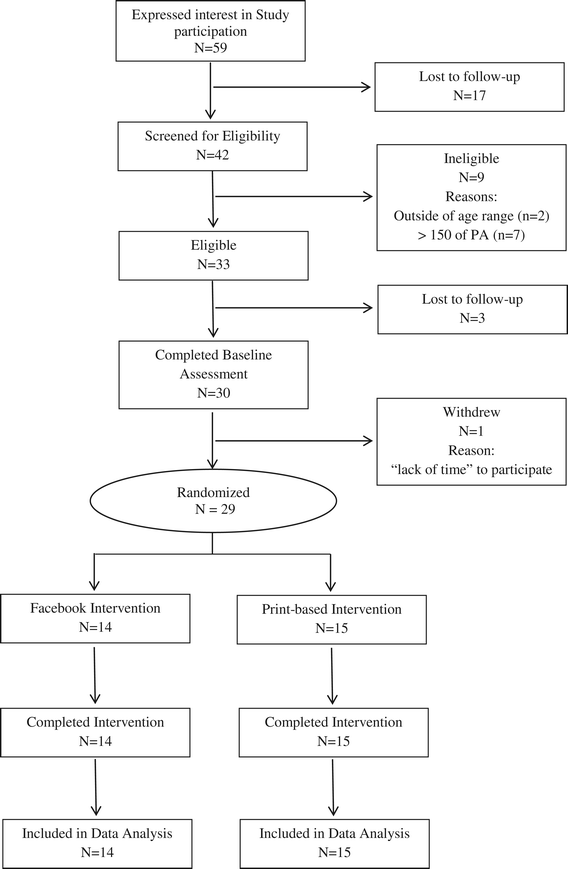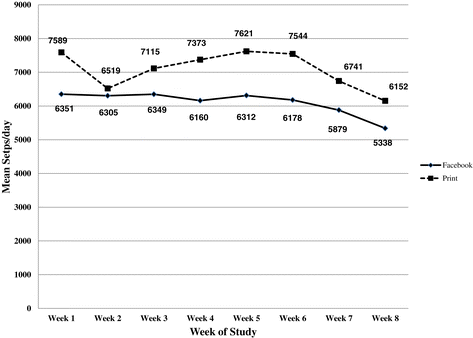Print versus a culturally-relevant Facebook and text message delivered intervention to promote physical activity in African American women: a randomized pilot trial
- PMID: 25886945
- PMCID: PMC4407714
- DOI: 10.1186/s12905-015-0186-1
Print versus a culturally-relevant Facebook and text message delivered intervention to promote physical activity in African American women: a randomized pilot trial
Abstract
Background: African American women report insufficient physical activity and are disproportionally burdened by associated disease conditions; indicating the need for innovative approaches to promote physical activity in this underserved population. Social media platforms (i.e. Facebook) and text messaging represent potential mediums to promote physical activity. This paper reports the results of a randomized pilot trial evaluating a theory-based (Social Cognitive Theory) multi-component intervention using Facebook and text-messages to promote physical activity among African American women.
Methods: Participants (N = 29) were randomly assigned to receive one of two multi-component physical activity interventions over 8 weeks: a culturally-relevant, Social Cognitive Theory-based, intervention delivered by Facebook and text message (FI) (n = 14), or a non-culturally tailored print-based intervention (PI) (n = 15) consisting of promotion brochures mailed to their home. The primary outcome of physical activity was assessed by ActiGraph GT3X+ accelerometers. Secondary outcomes included self-reported physical activity, physical activity-related psychosocial variables, and participant satisfaction.
Results: All randomized participants (N = 29) completed the study. Accelerometer measured physical activity showed that FI participants decreased sedentary time (FI = -74 minutes/week vs. PI = +118 minute/week) and increased light intensity (FI = +95 minutes/week vs. PI = +59 minutes/week) and moderate-lifestyle intensity physical activity (FI = + 27 minutes/week vs. PI = -34 minutes/week) in comparison to PI participants (all P's < .05). No between group differences for accelerometer measured moderate-to-vigorous intensity physical activity were observed (P > .05). Results of secondary outcomes showed that in comparison to the PI, FI participants self-reported greater increases in moderate-to-vigorous physical activity (FI = +62 minutes/week vs. PI = +6 minutes/week; P = .015) and had greater enhancements in self-regulation for physical activity (P < .001) and social support from family for physical activity (P = .044). Satisfaction with the FI was also high: 100% reported physical activity-related knowledge gains and 100% would recommend the program to a friend.
Conclusions: A culturally-relevant Facebook and text message delivered physical activity program was associated with several positive outcomes, including decreased sedentary behavior, increased light- and moderate-lifestyle intensity physical activity, enhanced psychosocial outcomes, and high participant satisfaction. Future studies with larger samples are warranted to further explore the efficacy of technology-based approaches to promote physical activity among African American women.
Trial registration: ClinicalTrials.gov NCT02372565 . Registered 25 February 2015.
Figures
References
-
- Centers for Disease Control and Prevention. U.S. Physical Activity Statistics. 2010 [http://www.cdc.gov/physicalactivity/data/index.html]
-
- U.S. Cancer Statistics Working Group: United States Cancer Statistics . United States Cancer Statistics. Atlanta, GA: U.S. Department of Health and Human Services, Centers for Disease Control and Prevention and National Cancer Institute; 2010. 1999–2007 Incidence and Mortality Web-Based Report.
-
- Smith A. Smartphone ownership- 2013 update [http://pewinternet.org/Reports/2013/Smartphone-Ownership-2013.aspx]
-
- Lenhart A. Cell phones and American adults [http://pewinternet.org/Reports/2010/cell-phones-and-american-adults.aspx]
-
- Duggan M, Brenner J. Demographics of social media users- 2012 [http://pewinternet.org/Reports/2013/Social-media-users.aspx]
Publication types
MeSH terms
Associated data
Grants and funding
LinkOut - more resources
Full Text Sources
Other Literature Sources
Medical
Research Materials
Miscellaneous



